
The bad economy has worried many of us. From losses on investments to lack of jobs, many of us worry about when the economy will turn around. Interestingly, the group most effected by high unemployment is youth. Last week, the Labor Department reported that youth unemployment stands at 18.2%, nearly twice the national average of 9.8%. The percentage of young people without a job is a staggering 53.4 percent, the highest figure since World War II. Those in the age group of 16-24 are most often the demographic who are hired for entry-level positions and groomed to take over high-level positions in the future.
Moreover, youth of color are disportionately effected by high unemployment. Nearly 40% of black youth (ages 16-19) and 30% of Latino youth (16-19) are unemployed versus only 23% of white youth. As youth of color get older, the gap widens-27.1% of black youth between the ages of 20-24 are unemployed versus 13.1% of white youth in the same age rage. This high unemployment rate for young people is startling because without more job opportunities, young people suffer not only in the short-term, but long-term. Their ability to attend college, afford healthcare, purchase homes, and save for retirement leads to long-term problems.
Rinku Sen and Billy Parish suggest in their joint article, that youth of color are the demographic who can most benefit from the new green jobs proposed by the Obama administration. These new jobs are proposed as a solution to both unemployment and saving our environment.
A few weeks ago I attended the Sikh Education Conference hosted by the Sikh Research Institute that brought together educators from across North America. One of the presentations focused on the importance of language education. The presenter made it quite clear – teaching young children multiple languages does not confuse them or hinder their development. In fact, research has shown that bilingualism and multilingualism is advantageous in several aspects. Exposure to two or more languages increases critical thinking skills, creativity, and flexibility of the mind in young children.
According to neurobiologists, the human brain is “hardwired” to learn languages as an infant and toddler. Any language learned during this period is stored, literally, in a different part of the brain than language acquired later in life, and in the right environment young children can learn up to four languages without significant slowdown. [link]
It seems, however, than in immigrant communities there is often hesitation around raising children in multilingual homes. The fear is that children will not learn English fast enough which will pose an obstacle to their assimilation into American society. It happens in our own community – young Punjabi children not being able to communicate with their older Punjabi grandparents. There is a language gap and if we consider the importance of oral tradition in our history – you can just imagine how much information is not being communicated and in fact being lost between generations.
Sotheby’s is having an auction today in New York of South Asian Modern and Contemporary Art including Miniature  Paintings.
Paintings.
Sotheby’s September 2009 auction of South Asian Art features a carefully-curated offering of works by leading modern and contemporary Indian artists, accompanied by an eclectic group of miniature paintings from the Rajput and Punjab Hills courts of northern India, as well as a selection of cutting-edge contemporary art from Pakistan. [Sotheby’s]
Of interest is a 1912 large portrait (approximately 5’x3′) of Guru Gobind Singh Ji estimated at $50,000-$70,000, as well as a miniature of all the Sikh Gurus with Guru Nanak Ji at the center, and a miniature of Maharaja Ranjit Singh on his stallion with weapons, accompanied by foot soldiers.
This large portrait of Guru Gobind Singh Ji, according to a Times of India article, is part of a series of four closely-related paintings depicting Guru Gobind Singh. Apparently each portrait was the inspiration for the next. It’s unclear where in the series this painting belongs or who the painter was, but the last painting in the series is currently on display at Hazur Sahib in Maharashtra and was created by Hari Singh.
Which leads to questions- if the last in the series is at the Hazur Sahib and this is at Sotheby’s, where are the other two? What path have these pieces taken? The works in this collection were probably passed down from one legitimate private owner to another. Perhaps they were commissioned by British officers. I have no evidence of anything otherwise.
But in general, the plunder from wars and violence often ends up on sale somewhere far from its source. The art and artifacts that were lost in Operation Bluestar weren’t inventoried. We don’t even have a way of identifying lost or stolen art in order to make a claim that it rightfully belongs to the community. Perhaps a budding art historian will be interested in a research project… attempting to document artwork remembered as being held at the Darbar Sahib or other sites of looting so that if it shows up on sale, we’ll be able to recover it.
According to a Deputy Director of Sotheby’s, the collector base for miniatures is largely made up of European, British and American collectors. It includes only a small group of NRIs. [TOI] Glad to see that we’re keeping our heritage intact for future generations! 😉
 The California legislator has unanimously passed a Kirpan Education Bill (AB 504) through both houses (Assembly & Senate); it is now headed to Governor Schwarzenegger’s desk. This bill, carried by Assemblymember Warren Furutani (D-Long Beach) and other co-sponsors, will only become law if the California Governator signs off on it. AB 504 is a historic bill because it is the only piece of legislation in America that focuses on Sikhs and our kirpan. Furthermore, the bill is being pushed through the law-making process in California-a state with the oldest and largest number of Sikhs in America.
The California legislator has unanimously passed a Kirpan Education Bill (AB 504) through both houses (Assembly & Senate); it is now headed to Governor Schwarzenegger’s desk. This bill, carried by Assemblymember Warren Furutani (D-Long Beach) and other co-sponsors, will only become law if the California Governator signs off on it. AB 504 is a historic bill because it is the only piece of legislation in America that focuses on Sikhs and our kirpan. Furthermore, the bill is being pushed through the law-making process in California-a state with the oldest and largest number of Sikhs in America.
The Kirpan Education Bill (AB 504) requires that all California law enforcement officers be trained on Sikhs and our kirpan. This training would teach California law enforcement officers about Sikhs and the importance of our religiously mandated articles of faith. Sikhs wearing a kirpan are often disrespectfully approached by law enforcement officers and arrested for concealed weapons charges. Often law enforcement officers will pull Sikhs over for minor traffic violations or safety concerns and as soon as officers see the kirpan the situation is escalated into a criminal offense; although the Sikh was only practicing his/her faith. These officers are unaware that the kirpan is a religious mandated article of faith-a gift from our Guru that we wear with care, respect, and love.
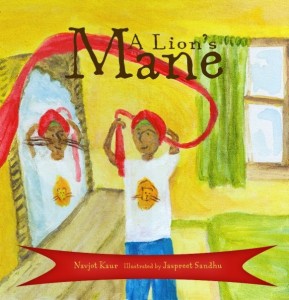 African American publishing houses were born out of a need – the need to fill a void in the industry. Bookshelves needed to share stories of their struggles and to give children a stake in their evolving identities. In turn, they gave rise to a new generation of diverse voices, with Asian-Pacific and Latino publishers following suit. They all have the same goal – to represent stories of their respective communities and give readers some authenticity and a sense of belonging. Now, consider this, how often did the covers of the books you read as a child have children who looked like you? Did these children’s books offer you a sense of belonging or importance? As our children enter into such a global community, it is clear that having access to authentic literature representing their heritage can only help ease the numerous challenges of peer pressure and to elevate self-esteem. Literature is perhaps the strongest avenue to enable us to realize our commonalities while teaching us about the idiosyncratic nature of one another.
African American publishing houses were born out of a need – the need to fill a void in the industry. Bookshelves needed to share stories of their struggles and to give children a stake in their evolving identities. In turn, they gave rise to a new generation of diverse voices, with Asian-Pacific and Latino publishers following suit. They all have the same goal – to represent stories of their respective communities and give readers some authenticity and a sense of belonging. Now, consider this, how often did the covers of the books you read as a child have children who looked like you? Did these children’s books offer you a sense of belonging or importance? As our children enter into such a global community, it is clear that having access to authentic literature representing their heritage can only help ease the numerous challenges of peer pressure and to elevate self-esteem. Literature is perhaps the strongest avenue to enable us to realize our commonalities while teaching us about the idiosyncratic nature of one another.
This is why we are so excited to bring you news about a new children’s book that promises to be “a staple on the shelves of young visionaries.” A Lion’s Mane, being released this month, is written by Navjot Kaur and illustrated by Jaspreet Sandhu. The book is published by Saffron Press, an independent publisher, aiming to encourage children to deepen their understanding of positive self-identity.
In this beautifully illustrated story, young readers journey to cultures around the world to explore the meaning of the dastaar, or turban of the Sikhs. Allusive words placed within a vibrant red dastaar help promote our connections as global citizens and encourage dialogue around issues of identity and kinship. [link]
This book certainly moves beyond the traditional in several ways. A Lion’s Mane brings a global perspective to the often misidentified image of the Sikh turban. It is printed on 100% recycled paper as well as displaying an Eco-Libris badge – 625 trees were planted for the first edition! In addition, a portion of proceeds from the sale of each book will support Seva Canada’s work to restore sight and prevent blindness in children. By shopping at Saffron Press, you really will be contributing to a green and ethical experience! We spoke with the author, Navjot Kaur, about the book and the challenges she underwent to have this story published. After the jump is the book trailer and the author’s first interview. As you view the information, consider this – how important is diverse and multicultural literature on the shelves of every library and school? Did you or do your children have access to this type of literature?
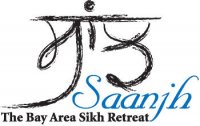
“Saanjh”-the annual Bay Area Sikh Retreat is taking place Thursday, August 27th-Sunday, August 30th at the Monte Toyon campsite near Santa Cruz, California. Share your experiences and connect with other Sikhs through a Guru-inspired sangat. This year’s theme is “Developing a Panthic Vision Towards 2084”. In 2009 we commemorate the 25th anniversary of 1984. When we fast-forward to its centennial where do we want to be as a Panth-a Sikh community? What is our collective vision for 2084? How do we need to develop as individuals and a community in order to heal ourselves and find solutions to our communal problems? Come share your opinions and connect with other concerned Sikhs through a collaborative approach to finding solutions. You will be inspired by diwans, conversations, debates, and laughter. Register by August 3rd to avoid late fees. There is a separate fee schedule for students and professionals. For more information visit www.saanjh.org. If you have any questions, e-mail sawal-jawab@saanjh.org.
As way of background, “Saanjh” began last year by a group of Bay Area Sikhs who were inspired by their personal experiences of engaging with sangats world-wide. They felt there was a need in California to “retreat” from our daily routines into a relaxed space where we could be inspired by our Guru. With this inspiration we could go back to our “real” lives as better engaged Sikhs spiritually, socially, and politically. The focus of the retreat is on learning from our experiences as diverse Sikhs in order to develop a collective vision for our community.
Oregon recently passed a bill to repeal its ban on religious attire in the workplace, a policy adopted 100 years ago as part of anti-Catholic backlash. However, it let stand an exception to this act — specifically, it continues to ban wearing “religious attire” in classrooms. Its decision strikes against its stated policy goal: to ameliorate religious discrimination in the workplace.
Religious affiliation is a protected class under U.S. equal protection (14th Amendment) and Civil Rights law, but it is subject to a much more lenient standard of review than other forms of discrimination (e.g., race). In 1980, the Supreme Court upheld Oregon’s workplace ban. The Legislature supports its ban by claiming that it is designed to avoid proselytization in the classroom. This is both misguided and continues to advance discrimination.
 Turbanology, or knowledge of Turbans, is a TV documentary recently released in the UK which explores the meaning of the turban in England since the London bombings. Filmmaker, Jay Singh-Sohal, was working for a conservative think-tank in the US when he first began considering the misconceptions surrounding the turban and the subsequent profiling of individuals and communities. The documentary discusses the origin and importance of the turban in modern Britain to “see whether it’s just harmless headwear or really the fashion of a fantatic”.
Turbanology, or knowledge of Turbans, is a TV documentary recently released in the UK which explores the meaning of the turban in England since the London bombings. Filmmaker, Jay Singh-Sohal, was working for a conservative think-tank in the US when he first began considering the misconceptions surrounding the turban and the subsequent profiling of individuals and communities. The documentary discusses the origin and importance of the turban in modern Britain to “see whether it’s just harmless headwear or really the fashion of a fantatic”.
The film addresses the impact 9/11 and 7/7 has had on the [mis]understanding of the turban as a symbol of fear, hatred and global terrorism. Australian researchers at the University of New South Wales published a study in 2008 which found that simply noticing someone could be a Muslim increased the aggressive tendencies on the part of non-Muslim westerners. They called it the “Turban Effect.” Turbanology seeks to raise awareness of the turban’s importance and discuss why the people who wear it consider it a crown. In the documentary, Jay Singh-Sohal speaks to music producers, politicians and ordinary Sikhs and Muslims who have been affected by wearing a turban. (A preview of the documentary can be seen after the jump).
“The documentary discovers that simply noticing someone could be a Muslim increases the aggressive tendencies of westerners. The give-away sign is the turban, and the beard. Whether conscious or sub-conscious, the fact that terrorism is a worry for many people means that there’s been a rise in profiling who could be a threat – an issue explored in the piece.” [link]
 The list of 1984-inspired Sikh propositions continue to grow. In the past, I have mentioned more than my fair share and last week my fellow langa(w)r-iter added one more. Here is another great proposal.
The list of 1984-inspired Sikh propositions continue to grow. In the past, I have mentioned more than my fair share and last week my fellow langa(w)r-iter added one more. Here is another great proposal.
This year marks the the creation of two great scholarships by the Jakara Movement. One aimed at high schoolers: “Bhai Amrik Singh Scholarship for Excellence” and the other at junior/community college transfers: “Bibi Upkar Kaur Scholarship for Excellence.” In this 25th year of commemoration of the 3rd Sikh Genocide (Ghallughara), these are the institutions that will last. The Scholarships provide national recognition and financial support for students, who exhibit outstanding academic strength as well as exceptional service to Sikhs and the American community at large.
The organizers describe them:
In honor of two pioneers of Sikh activism, Bibi Upkar Kaur and Bhai Amrik Singh’s exemplary dedication to the Sikh community are illustrated by their association with Sikh student organizations. Both were presidents of their respective Sikh student organizations and lived by their convictions of striving for excellence through dedication and perseverance in all aspects of their lives. Both applied this conviction to their educational pursuits, being accomplished students, and supportive of other students in pursuing academic excellence and achievement as well. They believed that as Sikhs, students had the obligation to not only excel in education, but also to carry the responsibility of being of service to the community. Bibi Upkar Kaur and Bhai Amrik Singh gave their lives for this very cause. Hence, these distinguished awards reflects Bibi Upkar Kaur and Bhai Amrik Singh’s legacies of commitment to academic excellence and service to the Sikh community as well as the greater community at large.
Early last week, a remarkable thing happened. Sikh children took to NYC streets again- some in strollers- and they were heard.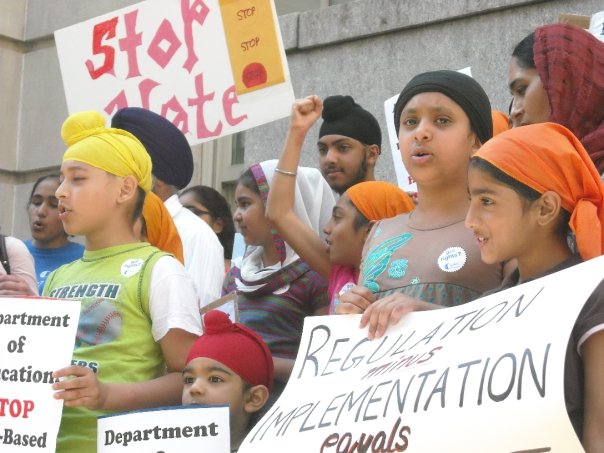
Last fall, the New York Department of Education passed a regulation in response to disturbing findings about the bullying that Sikh children face in schools. The regulation promised to define, track, and prevent bias-based harassment in NYC public schools. So after the first school year in which the regulation was in effect, how did the schools measure up?
The results were made public at a recent press conference by the Sikh Coalition and Sikh youth in NYC in front of the Department of Education’s headquarters. The Sikh Coalition teamed up with area organizations including the Coalition for Asian American Children and Families (CACF) and the Asian American Legal Defense and Education Fund (AALDEF), to release a report card grading the first year of the regulation’s implementation. Speakers at the press conference included representatives from Queens and Brooklyn schools and organizations such as the New York Civil Liberties Union (NYCLU), Desis Rising Up and Moving (DRUM), and Make the Road NY.
Problems remain, the report card shows. Based on the Sikh Coalition’s survey, there was no significant decline in the rate of harassment in the first year of the regulation’s implementation. [pg.9] Perhaps most disturbingly, out of all harassment reported by children, 16% was committed by a school official such as a teacher, school staff member, or security officer. [pg.12] In addition, after 90% of reported incidents of harassment to school officials, the school failed to properly follow protocol for investigation and follow-up. [pg.11]
For the full report card, click here.
Last week, I wrote a wrap-up about the 10th Annual Jakara Movement Conference. Sikh Knowledge, a previously featured artist, wrote his thoughts on his blog.
However, an especially important post was written by Pashaura Singh Dhillon. For those that are regular langa(r)-eaders, then you need no introduction. In a post during last year’s presidential election, I introduced a Fresno Punjabi landmark – one of our many great poets.
At last week’s Jakara Movement Conference, Pashaura Singh delivered a powerful poem at the farewell banquet. On his own blog, he introduces the piece, written with a contemporary problem using a traditional Mirza meter. I quote at length:
I was invited to share a poem I wrote at the closing banquet of Jakara Movement. Jakara began in 2000 with a mission to call the next generation of Sikhs from all places, backgrounds and points of view to reflect on their past and prepare for the future. In 2009, they came together as the next generation of Sikhs to continue the process of empowering, engaging , and educating the Sikh community.
Kanwar Anit Singh Saini (Sikh Knowledge) and Kanwar Singh (Humble the Poet), two Canadian rappers and participants of 2009’s Jakara said it best. “1984 is all around us. It is happening in Rwanda. It is happening in Palestine. We should try to find connections with people who are also victims because then the minority becomes the majority.”
But I was not there to repeat what had already been reported or was going to be reported on this subject. As a poet I wanted to invite them to a different plane, whereby they not only take the message of what happened to the Sikhs 25 years ago but also what is happening all around the world today and how it relates to us all. A big picture where these compounded atrocities and excesses not only of humans on humans that are happening everyday but also collectively of humans on this planet Earth, which threatens its very survival. The victim of human’s inhumanity the Earth pleads with the princess of the Skies whose domain the fugitive from Earth is now so impatient to intrude. Without further adieu, here is “Umber Di Shehzadi De Naa: To the Princess of the Skies”

Mark your calendars- the Kaur Foundation and the Asian Division of the Library of Congress have 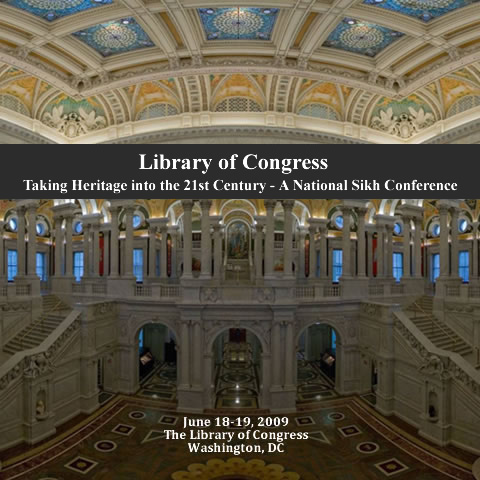 teamed up to undertake a unique initiative, to institutionalize knowledge by and about the Sikh community for future generations. The Library of Congress is the oldest federal cultural institution in the US, the largest library in the world, and the research wing of Congress. (LOC). The Sikh Collection Initiative is an effort to ensure that knowledge of and by Sikhs is collected and preserved for future generations. Given the tragic loss of valuable cultural and religious artifacts, manuscripts, and books from the Sikh Reference Library in the Darbar Sahib complex during Operation Bluestar, an initiative such as this begins to ensure that collective knowledge of our community will be preserved somewhere.
teamed up to undertake a unique initiative, to institutionalize knowledge by and about the Sikh community for future generations. The Library of Congress is the oldest federal cultural institution in the US, the largest library in the world, and the research wing of Congress. (LOC). The Sikh Collection Initiative is an effort to ensure that knowledge of and by Sikhs is collected and preserved for future generations. Given the tragic loss of valuable cultural and religious artifacts, manuscripts, and books from the Sikh Reference Library in the Darbar Sahib complex during Operation Bluestar, an initiative such as this begins to ensure that collective knowledge of our community will be preserved somewhere.
As our nation grows and becomes more diverse, it is critical that we appreciate and understand the different backgrounds of all that make this country great. Sikh Americans have significantly contributed to every field of human endeavor from technology, commerce, health, science, agriculture, to the arts – further enriching the cultural fabric of this land of immigrants.
He locked the washroom door, unravelled the nine-metre turban, took a pair of scissors and started cutting. Ten minutes later, three feet of hair lay in a pile and Charanbir Singh sat down and cried.
Outside, his parents and grandmother were in tears. Two friends persuaded him to come out, but Charanbir, his head wrapped in a towel, rushed to his room.
That was a year ago. Charanbir, now 17, still shudders at the memory. “I had to cut my hair.” (Link)
One of ironies of life in the 21st century western world is that despite an unparalleled degree of freedom of religion, the majority of people seem to be opting for freedom from religion.
Last week, Raveena Aulakh, a reporter from the Toronto Star, put a Canadian twist on the worldwide issue of apostasy amongst Sikh Youth.
Sikhism dates back to 15th-century India. Adherents are required to not cut their hair, considered a visible testament to their connection with their creator. The turban was adopted to manage long hair and make Sikhs easily identifiable.
For many young men in Greater Toronto, that is the problem: They don’t want to stand out.
Like other new or second-generation immigrants, many Sikh youngsters are desperate to fit in with the school crowd, while others complain of racism because they wear the turban. Add to that cultural influences, peer pressure and the desire to assimilate.
The end result? Many youngsters cut their hair, leading to family friction and, in some cases, lasting estrangement.
As a counterpoint, in the article and video above, Pardeep Singh Nagra (of boxing fame) presents his thoughts on why he’s decided to keep his hair.
Fear & Guilt
I’ve often wondered why so many Sikh youth keep their hair through high school but cut it as soon as they feel free from their parent’s control? From my perspective I see this as symptomatic of a great challenge facing Sikhs around the world today. Somehow, someway, we have fallen into the trap of pushing Sikhi to the next generation with fear and guilt, rather than sharing Sikhi through love.
Take your typical Sikh family; actually take mine. My now 25 year old cousin in Punjab had wanted to cut his hair since he was a teenager but two things stopped him. He was afraid that if he cut his hair his dad would beat him and then disown him. Secondly, he knew that if he did get a haircut and shave he wouldn’t be able to look his crying mom in the eye.
Unfortunately, there was little positive reinforcement around Sikhi in his life. Sure there was Sikhi by osmosis: visiting Gurdwaras, gurbani playing in the background, the odd sakhi told by our visiting grandfather. However, my cousin had little exposure to the aspects of Sikhi (nitnem, kirtan, seva, simran) that would have connected him with his faith on a deeper level. Most of the discussions with his parents were a flavour of the famous Goodness Gracious Me clip. So not surprisingly, upon entering college, he too cut his hair. And sure enough, he became our family’s black sheep, making a kid with already low self-esteem, feel even worse.
 Rice University senior, Sukhdeep Kaur, has received the Roy and Hazel Zeff Memorial Fellowship – a $25,000 grant, which will allow her to study issues of human rights and access to justice in areas around the world. The news release states:
Rice University senior, Sukhdeep Kaur, has received the Roy and Hazel Zeff Memorial Fellowship – a $25,000 grant, which will allow her to study issues of human rights and access to justice in areas around the world. The news release states:
A political science and policy studies major with a focus on law and justice, Kaur has a longstanding interest in human rights and justice issues that stems from the violent history between the Indian government and Sikhs in Punjab.
For her fellowship, Kaur will travel to four countries — Chile, Rwanda, Israel and France — to work with minority populations on the issues of access to human rights and justice.
I recently interviewed Sukhdeep and we discussed how she first got involved with human rights. “I knew I wanted to work with law and justice but wasn’t really sure whether to focus on civil rights or human rights,” Kaur said. However, after taking a human rights course her sophomore year and her personal study of the violence toward Sikhs in India in 1984 and subsequent human rights violations, she decided to make this the focus of her field work.
Many students face physical and psychological bullying in schools- elementary, middle, and high. But Sikh students, male and female, often face especially severe bullying. Over the past couple years, some severe cases have come into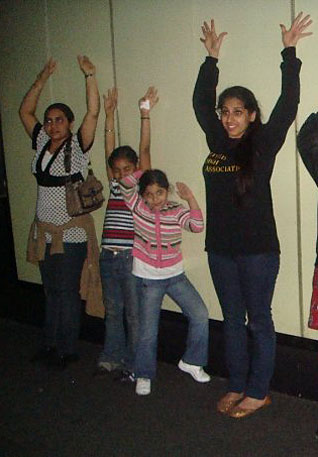 the public eye, including one teenager’s patka being set on fire, and others whose hair was forcibly cut. For statistics on the prevalence of harassment against Sikh students in New York schools, check out the Coalition’s report, “Hatred in the Hallways.”
the public eye, including one teenager’s patka being set on fire, and others whose hair was forcibly cut. For statistics on the prevalence of harassment against Sikh students in New York schools, check out the Coalition’s report, “Hatred in the Hallways.”
One pro-active student at Baruch College (of the City University of New York) has come up with a simple and creative way to provide support to kids facing harassment. Through his school’s Sikh Student Association, he started a mentoring program called Sikh Scouts. The students, aged 5-12 are paired with older Sikhs of the same gender, and go on a day’s outing together.
Sikh Scouts is essentially a small-scale Sikh youth mentoring event that aims to forge and develop a long-lasting relationship with children in need of good Sikh role models to help them guide them on the path of Sikhi. [link]
One of the students from Baruch that participated in the program wrote about the experience.
After they warmed up to us and broke through their initial shyness, the kids couldn’t stop talking about their favorite movies, TV shows and music – the Jonas Brothers and what not. And in between all of that, we got down to the serious issues: a majority of the kids did not enjoy school and felt uncomfortable because of harassment or teasing by their peers. [link]
There might not be much that anyone, including the older Sikh Scouts, can do to make the bullying stop- after all, kids will be kids. But what we older Sikh students can do for our younger counterparts is to be a source of strength, share insights about why it’s important to be comfortable with who you are whether it fits someone else’s definition of cool or not, and be there to offer advice for specific situations. There are things we’ve learned in hindsight that can benefit those facing the same harassment today.
Gatka owes its early development to the Shaster Vidiya, literally meaning knowledge of the arms. This was a warrior curriculum used by the Sikhs for military training. [link]
 A fascinating article in a UK newspaper highlights the return of Shaster Vidiya – the “world’s original martial art” which was banned by the Raj after the final defeat of the Sikh empire in the mid-19th century. Considered a forgotten art form, Shastar Vidiya was practiced in North India before the emergence of Sikhism. However, it was the Sikhs who were known to have fully mastered this particular fighting style.
A fascinating article in a UK newspaper highlights the return of Shaster Vidiya – the “world’s original martial art” which was banned by the Raj after the final defeat of the Sikh empire in the mid-19th century. Considered a forgotten art form, Shastar Vidiya was practiced in North India before the emergence of Sikhism. However, it was the Sikhs who were known to have fully mastered this particular fighting style.
Now, it seems, young British Sikhs are attempting to revive this lost art form. Their teacher, a controversial figure named Nidar Singh Nihang, has been studying the art of Shastar Vidiya for the past 20 years in hopes of passing it onto the younger generation. Students begin learning how to fight with simple wooden sticks. However, those who show a particular skill and dedication are allowed to practice with the kind of swords that once made the Sikh armies so powerful. The article points out the irony of a British Sikh trying to resurrect shastar vidiya given the history,
On TLH we have posted on the importance of Punjabi/Khalsa Schools. I have found that despite many students’ resistance to attend these schools, they plant the seeds for future exploration into Sikhi. At the age of 12 you may think you are too cool for school on Sundays, but at 19-20 or even 30 that experience creates a base for you to delve more deeply into your spiritual identity. Thus, I think it is extremely important that each Sikh community have at least one good Punjabi/Khalsa school. Ideally, I would want each Gurdwara to have one.
However, Punjabi/Khalsa Schools run into problems because in some way or another they become linked with communal politics. Most often this politics infiltrates schools within Gurdwaras. I think a fundamental component of a Gurdwara is a Punjabi/Khalsa School as is a Langar Hall. However, for many Gurdwaras, Punjabi/Khalsa Schools are a last priority. Gurdwara committees will fund new kitchen appliances before making a commitment to continually fund a Punjabi/Khalsa School. Thus, some community members have decided to create Punjabi/Khalsa Schools outside of the Gurdwara in local community-centers. When I hear this, I am both excited and disappointed. Excited that a school has been established; but disappointed that we are showing Sikh youth that we have to step outside of our main institution, the Gurdwara. How are we supposed to socialize our children into a Gurdwara-going culture when our leadership doesn’t support it in action? It’s a Catch 22. I don’t blame community members for creating schools outside of the Gurdwara. Their circumstances are real and, many times, this is their only feasible option. Or is it?
SGPC Chief Avtar Singh Makkar recently put forth the stunning idea that the Sikh religion doesn’t permit women to wear jeans. Apparently jeans, along with sleeveless shirts, “attract undue attention and distract others.” [link]
 The background story:
The background story:
…authorities in educational institutions run by the Shiromani Gurdwara Prabandhak Committee are … advising girl students wearing jeans or sleeveless shirts to “go home and change”.
Though the gurdwara body does not have any written rule on the matter, its employees in schools and colleges across Punjab insist hip-hugging denims and bare female arms are too provocative and liable to distract male teachers and students. There have been many recent instances at Ludhiana’s highly-sought-after Guru Nanak Engineering College, where women students were turned out of classrooms and told to stay away unless they went home and changed into “more respectable attire”.
SGPC chief Avtar Singh Makkar actually acknowledges the unwritten rule. “We discourage girls from wearing anything other than the usual salwar kameez because Sikh religion doesn’t permit dresses like jeans, pants or other similar wear.” [link]
What’s wrong with his statement? So many things… only one of which is Makkar’s use of the Sikh religion to promote his personal viewpoint and ultimately, the failure in leadership it illustrates.
There was an interesting story recently on Cultural Diversity Day at a local middle school. In addition to featuring dancing, self-defense, and dialogues, a few speakers lectured on their experiences or cultures, including a Sikh speaker:
Wearing a bright blue turban that matched his outfit, Gurparkash Singh, a scientific writer for Bristol-Myers Squibb, told about the Sikh faith. He said it’s easy to identify a Sikh person by looking at the shape of his or her turban. Sikh turbans are triangular and stop at the nape of the neck.
The writers covering the story spoke of the event as going “beyond diversity” and pushing forward what cultural diversity days are all about. It sounds like the event was really well-rounded and incorporated a lot of communities and backgrounds (and probably went far beyond “cultural” diversity to many different concepts of community diversity). I find myself uncomfortable, however, with classifying a religious community as “cultural,” and further, with tokenizing different communities on a single day of diversity awareness instead of incorporating a diversity-framework or lens into an educational or pedagogical model.
What exactly is the function of a Sikh Student Association? Is it simply to bring Sikh students together on campus for token meetings? Is it to celebrate Vaisakhi by organizing bhangra parties? Is it a platform to mobilize students to act upon issues impacting Sikh youth and the Sikh community? Is it… okay, I’ll stop with the questions.
To be quite honest, I don’t know the answers to these questions. I can speak to what I think the potential of such organizations is – what they could achieve and how an active and effective Sikh Student Organization could impact change. For example, here on TLH we’ve previously discussed how Sikh Student Associations in California have organized student initiated Kirtan and come together for Nagar Kirtans. Last week Camille discussed an initiative taken up by the University of Texas Sikh Student Association (the post stirred up some issues about the role of Sikh student associations). While these events are sporadic and intermittent – they are an example of one of the functional elements of a Sikh Student Organization – to educate ourselves and others about Sikhi.
However, it has to go beyond that. While I think any and all Sikh Student Associations should be given accolade for planning and participating in activities such as weekly Rehraas – there is much more to be achieved. Perhaps what’s integral to the success of these organizations (and to ensure they are effective) is to create an umbrella organization which provides resources and support to local Sikh Student Associations.
Take B.O.S.S. for example,
The British Organisation of Sikh Students is a non-political, non-profit making, independent body which acts as an umbrella organisation helping to develop, assist and support Sikh youth groups. [link]
